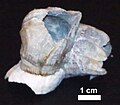Top Qs
Timeline
Chat
Perspective
Yorktown Formation
Geological Formation in the United States From Wikipedia, the free encyclopedia
Remove ads
The Yorktown Formation is a mapped bedrock unit in the Coastal Plain of Maryland, Virginia, North Carolina and South Carolina. It is overconsolidated and highly fossiliferous.
Remove ads
Description
The Yorktown is composed largely of overconsolidated sand and clay with abundant calcareous shells, primarily bivalves.
Stratigraphy
The Yorktown unconformably overlies the Miocene Eastover Formation, and conformably underlies the Pliocene Croatan Formation.[2]
The Yorktown was divided into members by Ward and Blackwelder (1980). These are in ascending order: Sunken Meadow Member, Rushmere Member, Morgarts Beach Member, and Moore House Member.[3] The uppermost Tunnels Mill Member is recognized in Maryland only.
Notable exposures
- Type Section: Yorktown, Virginia on southwest side of York River, York County
- Carters Grove Bluffs, north side of James River[4] 37°12′33″N 76°38′00″W
- Moore House Bluff, southwest side of York River, York County 37°13′25″N 76°29′14″W (very close to type section)
Remove ads
Age
Hazel (1971) revised the age of the Yorktown from Miocene to Late Miocene to Early Pliocene using ostracod biostratigraphy.[5] The age was revised by Gibson (1983) to extend into the Middle Pliocene based on foraminifera.[6] Further biostratigraphic work with ostracods and foraminifera was completed by Cronin (1991), which also summarized previous investigations.[7]
Fossils
- Bivalves, including Glycymeris subovata, Chesapecten jeffersonius, Chesapecten madisonius, Mercenaria tridacnoides, Panopera reflexa,[8] Chama, Ensis, Striarca and Noetia (see Noetiidae), Cerastoderma, Dosinia, Mulinia, Kuphus (Shipworm), Panope (Geoduck), and the oyster Ostrea
- Gastropods, including Crucibulum, Calliostoma, Busycon, Turritella, and Crepidula
- Foraminifera, including the biostratigraphic marker species Dentoglobigerina altispira (see Globigerinida), Sphaeroidinellopsis, and Globorotalia puncticulata[9]
- Scleractinian corals, including Septastrea marylandica, Paracyathus vaughani (see Caryophylliidae), and Astrangia lineata
- Ostracods
- Bryozoans
- Barnacles, including Balanus
- Worms
- Sponges
- Birds, including the large pelican Pelecanus schreiberi.
- Whales, including the prehistoric sperm whale Scaldicetus.
Gallery
References
Wikiwand - on
Seamless Wikipedia browsing. On steroids.
Remove ads





